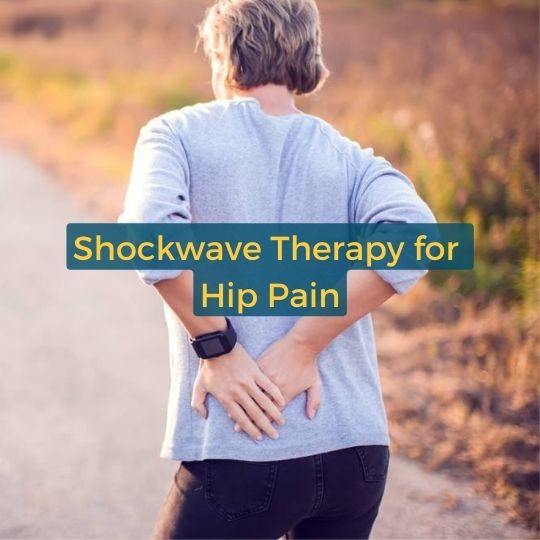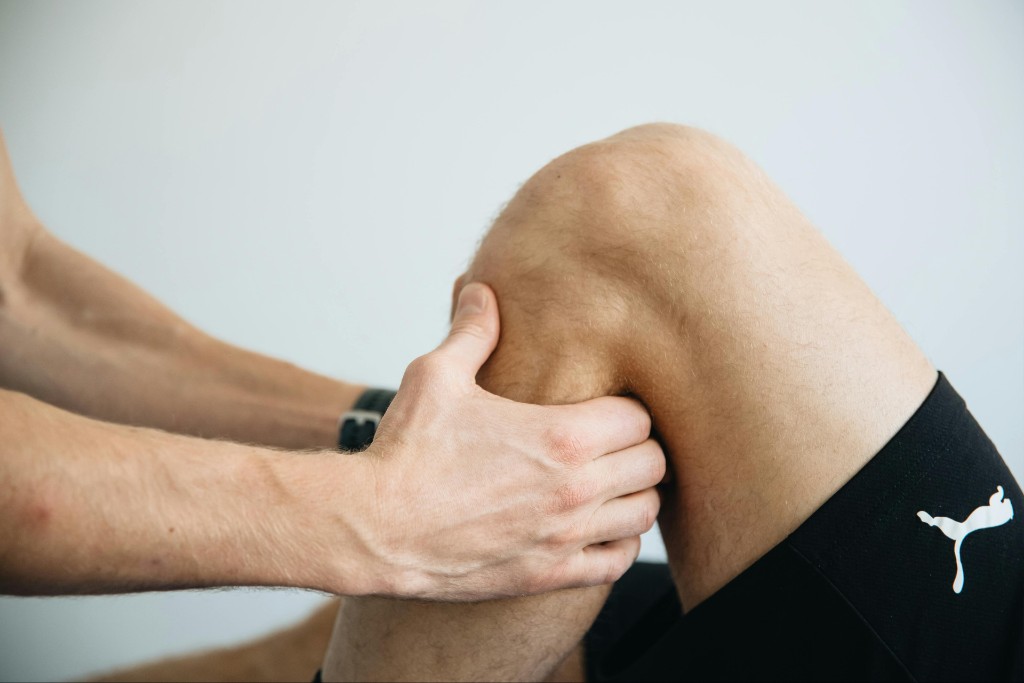A significant number of adults will encounter hip pain at some stage in their lives, making it a widespread health concern. Despite various treatment options, not all methods yield satisfactory results, leading patients to explore alternative solutions for pain relief. Recent research indicates that shockwave therapy could be a valuable approach to managing hip pain without the high costs and side effects associated with surgery and prescription medications.
In this blog post, we will explore:
- Causes of Hip Pain
- Advantages of Shockwave Therapy for Hip Pain
- How Shockwave Therapy Works
- What is a Shockwave?
- How do Shockwaves Treat Hip Pain?
- Types of Shockwave Therapy
- Who is a Good Candidate for Shockwave Therapy?
- The Shockwave Therapy Procedure
- Shockwave Therapy Side Effects
- The Best Shockwave Therapy for Hip Pain
Causes of Hip Pain

Various factors can contribute to hip pain, including poor posture, injuries, and underlying medical conditions. Some common causes of hip pain include:
- Muscle or tendon strains: Overexertion, improper movements, or sudden actions can result in strains or inflammation in the hip muscles and tendons, causing pain.
- Bursitis: Inflammation of the bursae, fluid-filled sacs that cushion joints, can lead to hip pain.
- Arthritis: This degenerative joint disease can affect the hip joint, causing pain and stiffness.
- Fractures: Hip fractures, common in older individuals and those with osteoporosis, can cause severe hip pain.
- Injuries from accidents or sports: Falls, car accidents, and sports-related activities can lead to hip injuries and pain.
- Sciatica or hip labral tears: These conditions can cause chronic hip pain.
It is crucial to remember that these are merely some common causes of hip pain. If you are experiencing hip pain, you can learn if your condition is suitable for treatment and try shockwave therapy with our New Patient Special.
Considering Shockwave Therapy?
Try SoftWave Therapy for just $69. Non-invasive healing that reaches deeper.

Advantages of Shockwave Therapy for Hip Pain
Shockwave therapy is a promising, non-invasive option for treating hip pain that offers various benefits. This therapy uses high-energy shock waves to stimulate healing in the affected region. Here are some advantages of employing shockwave therapy for hip pain:
Enhanced Healing
Shockwave therapy utilizes high-energy acoustic waves to activate the body’s innate healing process, accelerating the healing of damaged tissues such as muscles and tendons. This can be particularly beneficial for those with chronic or recurrent hip pain.
Reduced Reliance on Medications
Many conventional hip pain treatments involve medications with potential side effects. Shockwave therapy offers a drug-free alternative, reducing the need for pain medication or other therapies. This makes it an attractive option for those who prefer non-pharmaceutical treatments.
Improved Quality of Life
Hip pain can significantly impact daily life, making it challenging to complete everyday tasks or enjoy hobbies. Shockwave therapy can help reduce pain and enhance mobility, enabling patients to return to their regular activities and improve their quality of life.
Non-Invasive and Safe
Unlike many hip pain treatments, shockwave therapy is non-invasive and safe. It does not require incisions or anesthesia and has a low risk of complications. This makes it a suitable choice for those looking to avoid more invasive treatments.
Overall, shockwave therapy is a promising treatment option for individuals suffering from hip pain.
How Shockwave Therapy Works
Shockwave therapy is a non-invasive treatment that uses high-energy acoustic waves to stimulate the body’s natural healing process. Here’s how it works:
What is a Shockwave?
Shock waves are rapid acoustic pulses characterized by a high-pressure surge followed by a relatively lower-pressure trough. These phenomena are part of our daily lives and can be produced by various sources such as supersonic aircraft, explosions, lightning, earthquakes, or any other event that causes a change in air pressure.
How do Shockwaves Treat Hip Pain?
A device generates and safely delivers shockwaves to the affected hip area. These shockwaves can promote healing at the cellular level, improve blood supply, and initiate the body’s natural healing process.
Types of Shockwave Therapy
There are several types of shockwave therapy on the market, with the three most common being radial shockwave therapy (RSWT), focused shockwave therapy (FSWT), and acoustic wave therapy (AWT).
Radial Shockwave Therapy uses a hand-held device that applies pressure waves to the skin’s surface. This type of shockwave therapy is a popular option for treating conditions such as plantar fasciitis, Achilles tendinopathy, and tennis elbow. However, it may not be effective for deeper tissue injuries, and patients may require multiple treatment sessions.
Focused Shockwave therapy uses a device that delivers high-intensity shockwaves directly to the affected area. This type of shockwave therapy is often used for treating chronic conditions like plantar fasciitis and bone fractures that are slow to heal. However, it can be uncomfortable for some patients, and the intensity of the treatment may need to be adjusted based on individual needs.
Acoustic Wave Therapy uses a device that delivers low-intensity shockwaves to the affected area. This type of shockwave therapy is commonly used to improve blood flow, reduce pain and inflammation, and promote tissue healing. It is often used to treat conditions such as erectile dysfunction and cellulite. However, the low-intensity shockwaves may not be effective for treating some conditions.
broad-focused Shockwave Therapy delivers high-intensity shockwaves that penetrate a wider and deeper area of tissue (7cm x 12cm) than focused shockwaves (1cm x 12cm) or radial waves (2cm x 2cm). SoftWave for hip pain is the only broad-focused shockwave treatment widely available in the US. broad-focused shockwaves can treat the same conditions as traditional focused shockwave therapy, while providing superior relief for large joints and muscle issues such as hip joints. broad-focused shockwaves may also require fewer sessions compared to radial or focused shockwave treatments.
Who is a Good Candidate for Shockwave Therapy?

Some factors that make a patient a suitable candidate for shockwave therapy include:
- Patients with chronic hip pain
- Patients with limited success with other therapies
- Patients who prefer non-invasive treatment options
Patients suffering from chronic hip pain may find shockwave therapy a viable treatment option. This includes those with conditions such as osteoarthritis, hip bursitis, and sciatica. In cases where traditional treatments, such as medication and physical therapy, fail to provide significant relief, shockwave therapy may offer a promising alternative.
Additionally, patients who have undergone other therapies with limited success may benefit from shockwave therapy for their hip pain. These may include individuals who have tried multiple conservative treatment options without experiencing adequate pain relief.
For patients who prefer non-invasive treatments, shockwave therapy offers a non-surgical approach that does not require incisions or anesthesia. This can make it an attractive treatment option for those who wish to avoid more invasive procedures, such as hip replacement surgery.
Considering Shockwave Therapy?
Try SoftWave Therapy for just $69. Non-invasive healing that reaches deeper.

The Shockwave Therapy Procedure
Understanding what to expect during a shockwave therapy session is an important step for patients considering this treatment option for their hip pain. In this section, we’ll break down the shockwave therapy procedure:
- Preparation: Before the procedure, ultrasound gel is applied to the affected hip area. The shockwave device is then gently placed on the skin.
- During the Procedure: Patients will feel a gentle tapping or pulsing sensation as shockwaves are delivered to the injured area. Some may experience mild pain or discomfort, but anesthesia or numbing agents are not necessary. Effective communication between the patient and provider can help identify treatment hotspots and track progress.
- After the Procedure: After the 10-15 minute procedure, patients can typically resume normal activities, with no downtime for recovery required. Some doctors will recommend avoiding high-impact movements or exercise for 24-48 hours.
Shockwave Therapy Side Effects
Shockwave therapy is generally considered safe and well-tolerated, with minimal side effects. However, like any medical procedure, there is a small risk of side effects. Some of the most commonly reported side effects of shockwave therapy for hip pain include:
- Pain or discomfort during or after treatment
- Swelling or bruising
- Redness or skin irritation
- Numbness or tingling
It’s important to note that these side effects are typically mild and short-lived. Most patients are able to resume their normal activities immediately following the procedure.
FDA-cleared SoftWave is a safe and effective shockwave therapy for hip pain. Side effects from SoftWave are minimal and non-restrictive. It does not cause bruising or swelling, and any slight redness or soreness typically subsides within one to two days.
The Best Shockwave Therapy for Hip Pain
Are you looking for safe, reliable, and effective relief from hip pain?
SoftWave therapy is FDA-cleared, patented, and nationally recognized for its leading tissue regeneration technology. Unlike other types of high-energy shockwave treatments, SoftWave is the only shockwave therapy on the market that uses true broad-focused shock waves that treat larger and deeper areas of tissue.
Thousands of patient’s have experienced the benefits of SoftWave for hip pain, including:
- Little to no side effects
- Short treatment time
- Quick recovery
- Long-lasting results
Find a SoftWave Therapy provider near you or learn more about SoftWave and whether or not you’re eligible for full treatment today!
New Patient Special
Try SoftWave for just $69 at a clinic near you and learn if you’re a candidate for full treatment





